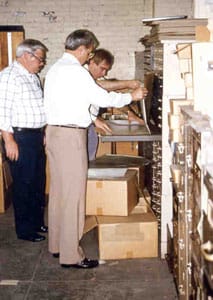History of the RSA

In this two-part video, historian Roy Marcot takes a seat at the Las Vegas Antique Arms Show to share the fascinating history of the Remington Society of America, offering insights into its origins, mission, and contributions to firearms scholarship.
Part 1
Part 2
Early History
A Remington Collector’s Group is Formed
In 1981, a small group of collectors met at the Karl Moldenhauer Auction and talked about forming an organization to further the study of Remington antique firearms. The first official meeting of more than two dozen dedicated Remington collectors took place at the Winter Antique Arms Show in Las Vegas in January 1982 — and thus the Remington Society of America was formed. Fritz Baehr was elected its first president, a position he held for six years.
During the remainder of the 1980s, the fledgling organization — known to many as RSA — held annual membership meetings and published infrequent newsletters and briefs on Remington firearms. The membership grew slowly, but steadily. In 1988, Gordon Stanley was elected President to succeed Fritz Baehr.
RSA’s Relationship with Remington Arms Company
In the early 1990s, RSA began cementing an association with the gun-making corporation Remington Arms Company, Inc. and Remington Ammunition Manufacturing– a relationship that has grown stronger ever since. This symbiotic relationship gave the firearms manufacturer what it needed — an expertise in the historical aspects of the company — and gave RSA an entry into the long closed records of the manufacturing company in Ilion, New York.
Art Wheaton – Remington VP of Marketing & Sales (center) is flanked by Simeon Stoddard – Curator of the Cody Firearms Museum (left) and by Jay Huber – RSA Director (right).
The Remington Research Team
In 1991, RSA formed a Remington Research Team to conduct primary research at the factory on original correspondence, production ledgers, rare photographs and shop drawings. This marked the first time in many decades that the company permitted outsiders to work on its proprietary records. The team now numbers fourteen dedicated individuals, each with a different Remington expertise: early Remington history, Civil War revolvers, hunting rifles, catalogs and brochures, modern shotguns, etc. One or two week-long research trips were made by the team members to the Remington gun factory in Ilion, NewYork each year, and to the Remington ammunition plant in Lonoke, Arkansas, less frequently.
The Room That Doesn’t Exist
Researchers who went to the Remington Arms Company facility in Ilion, New York prior to 1991 were given the official statement: “There are no Remington production records!” Visitors who pilgrimaged to Ilion were stopped at the museum director’s office and politely told that their quest was over… “as no records exist.”
What the researchers didn’t know was that the museum director was simply following orders from the top from duPont management – that didn’t want Remington workers “bothered” by researchers and student of firearms. DuPont’s philosophy was that “history doesn’t sell present-day guns.”
The ice would thaw in early 1991, when researchers Slim Kohler, Roy Marcot and Jay Lewis went to Ilion to study the Remington Museum’s pistols and rolling block rifles. On the fourth day of a week-long research trip, their devotion to things Remington impressed two Remington employees – Ken Green and Jack Heath – who did the unthinkable: they opened Pandora’s Box! The three researchers were told that they would be shown “the Remington records”, but if they divulged this secret to anyone, the door would be shut forever! As far as Slim, Roy and Jay were concerned, “This was the room that didn’t exist!”
Researchers Jay Lewis, Roy Marcot and Slim Kohler smile, because they were just shown the Remington records for the first time.
(January 1991)
On that fateful day, the three wide-eyed researchers were taken to the top floor of a triple-locked area that was off-limits to all but a handful of Remington employees. What was revealed was a locked L-shaped room that contained decades old Remington production records, drawings, photographs and ledgers. Some were neatly stored in cabinets and drawers, but others were strewn about in no order what-so-ever. The trio were allowed only one hour in “the sacred place”, and then were ushered out… and warned again about keeping the secret.
What Remington didn’t want was an unslought of looky-loo’s and tire-kickers clammering to see the records. Remington employees had neither the time, nor the inclination to cater to such unprofessional antics. So Roy Marcot put together a plan – to propose to Remington that a small number of serious researchers be allowed to return to Ilion to work on the materials – including preserving, categorizing, sorting and protecting Remington’s precious history.
The plant manager, John Winskie, himself a history buff, was persuaded to give Roy’s plan a try… as long as the team didn’t divulge Remington’s secret. And thus, the RSA Research Team was formed with the following initial members:
Roy Marcot – Authority on Remington Rolling Block Firearms
Slim Kohler – Expert on E. Remington and Sons’ Pistols and Revolvers
Jack Heath – Remington Arms Company Historian
Leon Wier, Jr. – Authority on E. Remington and Sons’ Pistols and Revolvers
Jay Huber – Expert on nearly all arms of E. Remington & Sons
Jane Spellman – Director of the Herkimer County Historical Society
This team returned to Ilion in late 1991, to begin the difficult task.
The Remington Society’s Quarterly Publication – The RSA Journal
In the late 1980s, RSA began sharing its historical and technical knowledge in a published newsletter. By 1991, the popularity of the publication grew into an eight page magazine, and then grew into a 40-page RSA Journal. Now, 30 years later, the quarterly Journal consists of a full color cover and 72 pages of Remington history, firearms, ammunition and personalities. The RSA Journal is recognized as being a premier periodical among the dozen or more gun collecting groups in America today.
Annual RSA Historical Seminars
The Remington Society holds annual historical seminars each year, to better educate its membership in “things Remington!” The three-day seminars are conducted at locations important to the history of Remington. Over the past six years attendees have seen the original Remington Homestead (dating back to 1810), the site of the first Remington Forge, the location of the first manufacturing plant, and the facility where billions of rounds of ammunition are made each year.
Since 1991 attendees have enjoyed RSA Historical Seminars across the United States at such destinations as the Remington Plant in Ilion, NY, Lonoke, AR, and Huntsville, AL as well as the Cody Firearms Museum and NRA Museums to name a few.
The Remington Firearms Exhibit at Jekyll Island
In the summer of 2000 RSA was invited to exhibit Remington firearms that were relevant to an island on the coast of Southern Georgia in the late 19th and early 20th Century. The exhibit was entitled: THE HUNT: Game, Guns and Gentlemen of Jekyll Island, and was on display from May through August, 2000. The island is important in Remington history because two of its owners had summer homes on Jekyll Island: Marcellus Hartley and Marcellus Hartley Dodge. Remington arms owned by RSA members and sold by the company between 1888 and 1933 were on display all summer long.
Books about Remington History and Firearms
Since its inception in the early 1980s, more than a dozen books have been published on Remington firearms by RSA members. Shared knowledge allows others to appreciate the history and collecting interests of the firearms, and furthers the hobby for many new collectors. A complete listing of these books, and availability, is in the Remington BOOKS web page of this web site.







